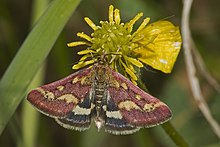
Obtectomera

| Obtectomera | |
|---|---|

| |
| Pyrausta purpuralis | |
| Scientific classification | |
| Domain: | Eukaryota |
| Kingdom: | Animalia |
| Phylum: | Arthropoda |
| Class: | Insecta |
| Order: | Lepidoptera |
| Clade: | Neolepidoptera |
| Infraorder: | Heteroneura |
| Clade: | Eulepidoptera |
| Clade: | Ditrysia |
| Clade: | Apoditrysia |
| Clade: | Obtectomera Minet, 1986 |
The Obtectomera is a clade of macro-moths and butterflies, comprising over 100,000 species in at least 12 superfamilies.[1][2] This clade was initially defined by a pupal stage with the four anterior abdominal segments fused and immobile as the sole synapomorphy, but was later revised to include the modification of the dorsal edge of the pulvillus with a protrusion in the adult.[3]

Taxonomy
The Obtectomera includes the following 12 superfamilies:[1]

- Whalleyanoidea Minet, 1991
- Thyridoidea Herrich-Schäffer, 1846 – picture-winged leaf moths
- Hyblaeoidea Hampson, 1903 – teak moths
- Calliduloidea Moore, 1877 – Old World butterfly-moths
- Papilionoidea Latreille, 1802 – true butterflies
- Pyraloidea Latreille, 1809 – pyraloid moths
- Mimallonoidea Burmeister, 1878 – sack bearers (sometimes included Macroheterocera[2])
- Macroheterocera Chapman, 1893
- Drepanoidea Boisduval, 1828 – drepanids
- Noctuoidea Latreille, 1809 – owlet moths
- Geometroidea Leach, 1815 – inchworms
- Lasiocampoidea Harris, 1841 – lappet moths
- Bombycoidea Latreille, 1802 – bombycoid moths
Some other superfamilies are sometimes included:[2]

- Pterophoroidea Latreille, 1802 – plume moths
- Alucitoidea Leach, 1815 – many-plume moths
- Copromorphoidea [=Carposinoidea[1]] Walsingham, 1897 – fruitworm moths
- Epermenioidea Spuler, 1910 – fringe-tufted moths
- Gelechioidea Stainton, 1854 – case-bearers, twirler moths, curved-horn moths, etc.
The macroheteroceran superfamilies were previously place in the Macrolepidoptera, but recent molecular studies have failed to recover the Macrolepidoptera as a monophyletic group.[1][2] The latter grouping also included true butterflies (Papilionoidea), New World butterfly-moths (Hedylidae), Old World butterfly-moths (Calliduloidea), and European gold moths (Axioidea).

References
- ^ a b c d van Nieukerken, Erik J.; Lauri Kaila; Ian J. Kitching; Niels P. Kristensen; David C. Lees; Joël Minet; Charles Mitter; Marko Mutanen; Jerome C. Regier; Thomas J. Simonsen; Niklas Wahlberg; Shen-Horn Yen; Reza Zahiri; David Adamski; Joaquin Baixeras; Daniel Bartsch; Bengt Å. Bengtsson; John W. Brown; Sibyl Rae Bucheli; Donald R. Davis; Jurate De Prins; Willy De Prins; Marc E. Epstein; Patricia Gentili-Poole; Cees Gielis; Peter Hättenschwiler; Axel Hausmann; Jeremy D. Holloway; Axel Kallies; Ole Karsholt; Akito Y. Kawahara; Sjaak (J.C.) Koster; Mikhail V. Kozlov; J. Donald Lafontaine; Gerardo Lamas; Jean-François Landry; Sangmi Lee; Matthias Nuss; Kyu-Tek Park; Carla Penz; Jadranka Rota; Alexander Schintlmeister; B. Christian Schmidt; Jae-Cheon Sohn; M. Alma Solis; Gerhard M. Tarmann; Andrew D. Warren; Susan Weller; Roman V. Yakovlev; Vadim V. Zolotuhin; Andreas Zwick (23 December 2011). Zhang, Zhi-Qiang (ed.). "Order Lepidoptera Linnaeus, 1758" (PDF). Zootaxa. Animal biodiversity: An outline of higher-level classification and survey of taxonomic richness. 3148: 212–221.
- ^ a b c d Mitter, Charles; Davis, Donald R.; Cummings, Michael P. (2017). "Phylogeny and Evolution of Lepidoptera". Annual Review of Entomology. 62 (1): 265–283. doi:10.1146/annurev-ento-031616-035125. ISSN 0066-4170.
- ^ Minet, Joel (1991). "Tentative reconstruction of the ditrysian phylogeny (Lepidoptera: Glossata)". Insect Systematics & Evolution. 22 (1): 74.
See what we do next...
OR
By submitting your email or phone number, you're giving mschf permission to send you email and/or recurring marketing texts. Data rates may apply. Text stop to cancel, help for help.
Success: You're subscribed now !
